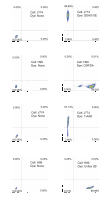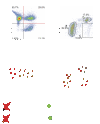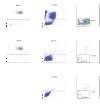Nonlytic exocytosis of Cryptococcus neoformans from macrophages occurs in vivo and is influenced by phagosomal pH
- PMID: 21828219
- PMCID: PMC3150755
- DOI: 10.1128/mBio.00167-11
Nonlytic exocytosis of Cryptococcus neoformans from macrophages occurs in vivo and is influenced by phagosomal pH
Abstract
A unique aspect of the interaction of the fungus Cryptococcus neoformans with macrophages is the phenomenon of nonlytic exocytosis, also referred to as "vomocytosis" or phagosome extrusion/expulsion, which involves the escape of fungal cells from the phagocyte with the survival of both cell types. This phenomenon has been observed only in vitro using subjective and time-consuming microscopic techniques. In spite of recent advances in our knowledge about its mechanisms, a major question still remaining is whether this phenomenon also occurs in vivo. In this study, we describe a novel flow cytometric method that resulted in a substantial gain in throughput for studying phagocytosis and nonlytic exocytosis in vitro and used it to explore the occurrence of this phenomenon in a mouse model of infection. Furthermore, we tested the hypothesis that host cell phagosomal pH affected nonlytic exocytosis. The addition of the weak bases ammonium chloride and chloroquine resulted in a significant increase of nonlytic exocytosis events, whereas the vacuolar ATPase inhibitor bafilomycin A1 had the opposite effect. Although all three agents are known to neutralize phagosomal acidity, their disparate effects suggest that phagosomal pH is an important and complex variable in this process. Our experiments established that nonlytic exocytosis occurred in vivo with a frequency that is possibly much higher than that observed in vitro. These results in turn suggest that nonlytic exocytosis has a potential role in the pathogenesis of cryptococcosis.
Importance: Cryptococcus neoformans causes disease in people with immune deficiencies such as AIDS. Upon infection, C. neoformans cells are ingested by macrophage immune cells, which provide a niche for survival and replication. After ingestion, macrophages can expel the fungi without causing harm to either cell type, a process named nonlytic exocytosis. To dissect this phenomenon, we evaluated its dependence on the pH inside the macrophage and addressed its occurrence during infection of mice. We developed new techniques using flow cytometry to measure C. neoformans internalization by and nonlytic exocytosis from macrophages. Neutralizing the phagosome acidity changed the rate of nonlytic exocytosis: activity increased with the weak bases chloroquine and ammonium chloride, whereas the vacuolar ATPase inhibitor bafilomycin A1 caused it to decrease. Experiments in mice suggested that nonlytic exocytosis occurred during infection with C. neoformans. These results shed new light on the interaction between C. neoformans and host macrophages.
Figures





References
-
- Casadevall A, Perfect JR. 1998. Cryptococcus neoformans, 1st ed. ASM Press, Washington, DC
-
- Park BJ, et al. 2009. Estimation of the current global burden of cryptococcal meningitis among persons living with HIV/AIDS. AIDS 23:525–530 - PubMed
-
- Shao X, et al. 2005. An innate immune system cell is a major determinant of species-related susceptibility differences to fungal pneumonia. J. Immunol. 175:3244–3251 - PubMed
Publication types
MeSH terms
Grants and funding
LinkOut - more resources
Full Text Sources
Other Literature Sources

